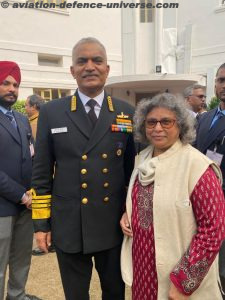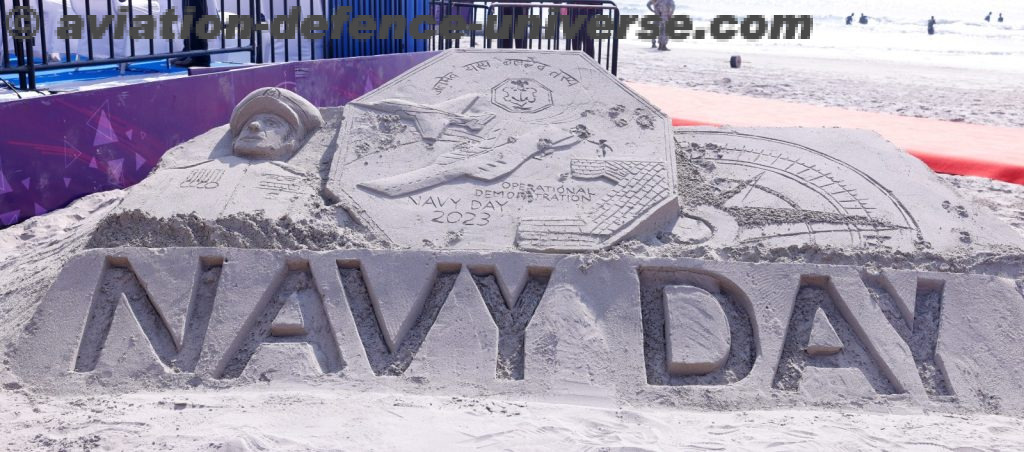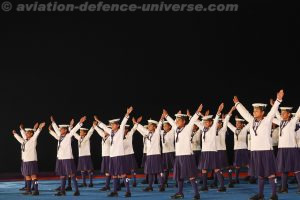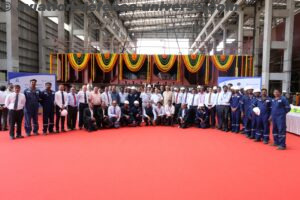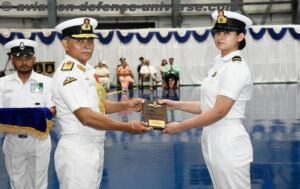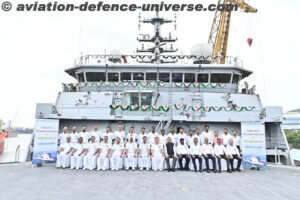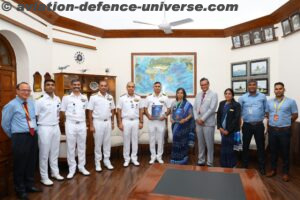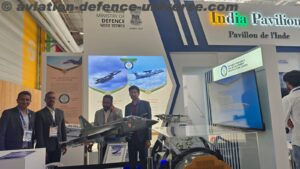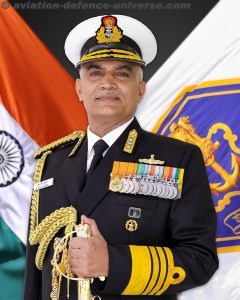 New Delhi. 15 December 2023. “The expansion plan of the Navy includes induction of Aircraft Carriers, state-of-the-art Next Generation Warships, nuclear-powered and conventional submarines, Carrier-based fighters, long endurance UAVs as well as augmentation of autonomous solutions to enhance combat capabilities, and induction of niche technology and equipment to address emergent and future threats,” stated Chief of Naval Staff , Indian Navy, Admiral R Hari Kumar, PVSM, AVSM, VSM, ADC while speaking exclusively with Aviation & Defence Universe (ADU) in an interview on Navy Day 2023.
New Delhi. 15 December 2023. “The expansion plan of the Navy includes induction of Aircraft Carriers, state-of-the-art Next Generation Warships, nuclear-powered and conventional submarines, Carrier-based fighters, long endurance UAVs as well as augmentation of autonomous solutions to enhance combat capabilities, and induction of niche technology and equipment to address emergent and future threats,” stated Chief of Naval Staff , Indian Navy, Admiral R Hari Kumar, PVSM, AVSM, VSM, ADC while speaking exclusively with Aviation & Defence Universe (ADU) in an interview on Navy Day 2023.
ADU. Based on the threat perception, capability advancement, and resource allocation, the Indian Navy has a very focused plan. What are the top areas of combat and surveillance capability that you will concentrate on for procurement keeping combat readiness in mind?
CNS. The Navy remains committed to maintaining a high level of operational preparedness to cater for all kind of threats, and progress its modernisation plans within the available resources. IN closely monitors its areas of interest, and constantly refines, updates and evaluates the maritime security environment. Towards this, a comprehensive MDA picture is continuously compiled through a complex sensor grid comprising on-shore assets and platforms at sea i.e. ships, submarines and aircraft and space-based surveillance. Autonomous solutions for surveillance are being explored to gradually augment manned platforms and to balance capability.
As regards combat potential, the Navy is developing capabilities to have a suitable force mix to meet all envisaged missions enabling requisite Power Projection and Sea Control capability in our Areas of Interest. As the Bharatiya Nausena evolves into a fully AatmaNirbhar Force, the Combat Capability of platforms is being given the highest priority.
In addition, the Navy is striving to enhance its surveillance capability through the induction of Long Range Maritime Aircraft and autonomous Surface, Underwater and Aerial Vehicles, with adequate impetus on emerging niche technologies such as AI and Robotics to enhance Bharatiya Nausena’s combat and surveillance capability.
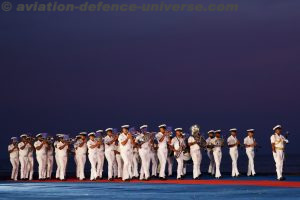 ADU. In the changed geo-polity of Indo-Pacific and South China Sea, what difference in role do you envisage for Indian Navy?
ADU. In the changed geo-polity of Indo-Pacific and South China Sea, what difference in role do you envisage for Indian Navy?
CNS. Bharatiya Nausena’s areas of interest encompasses the entire Indian Ocean Region, as well as the larger Indo-Pacific oceanic space. With the rise of the Indo-Pacific as the new centre of gravity of world affairs, our areas of interest have gained significant importance. As a result, a number of nations and actors are vying for resources and influence in the Region. Concomitantly, there is also an increased presence of extra-regional forces and naval assets in the Indo-Pacific, and especially in the Indian Ocean Region.
There is, thus, palpable competition that is unfolding in the region, and if not managed well, can lead to contestation or even conflict. Therefore, the Indian Navy will have to play a crucial role of helping shape a positive and favourable environment.
Towards that end, our actions are aimed at promoting security and stability at sea. These include naval deployments for exercising presence in our areas of interest, engagement with maritime forces of friendly nations, maritime capacity building and capability enhancement, cooperative efforts for the development of regional MDA, and conduct of maritime security operations, among others.
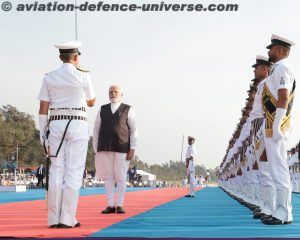
ADU. The 30-year submarine building and modernization plan is one of the most important parts of the Maritime Capability Perspective Plan (MCCP). Can you please give a status update on the steps taken to guarantee that the capability gaps are soon closed in anti-submarine warfare?
CNS. The 30 year Submarine Construction Plan was approved in 1999 and outlines the capability growth in the submarine arm. The plan has since been updated in the past decade factoring the growth achieved and future plans. Iaw the plan, we had concluded a contract for procurement of six submarines under Project 75. While five submarines have been inducted, the sixth is planned to be inducted next year (2024). We are also actively pursuing capability augmentation through additional Project 75 submarines as well as Project 75(I) submarines. While P75 submarines are at pre-RFP stage, P75(I) is at TEC stage. Concurrently, our current fleet of Shishumar class and Sindhugosh class submarines are being accorded upgrades including new weapon capabilities to ensure they remain combat and role-worthy.
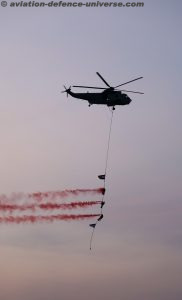 ADU. It was reported that Naval Headquarters has access to US Navy’s CENTRIX since COMCASA was signed. How much has it improved Maritime Domain Awareness for the Indian Navy?
ADU. It was reported that Naval Headquarters has access to US Navy’s CENTRIX since COMCASA was signed. How much has it improved Maritime Domain Awareness for the Indian Navy?
CNS. Communication Compatibility and Security Agreement (COMCASA) was signed between India and USA in Sep 18, which aims to enhance mutually secured communications capability through US DoD provided secured communication security equipment. As a proof of concept, two Combined Enterprise Regional Information Exchange Systems (CENTRIXS), i.e Coalition Maritime Forces Pacific (CMFP) and Coalition Maritime Forces Central (CMFC) were installed in Mar 19. This system provides a secure channel to communicate with partner nations of CMFP and CMFC. The availability of the CENTRIX systems has provided the following advantages:-
- Conduct of Coordinated/ Joint operations and advance level exercises with USN.
- Regular plot exchange of Vessels of Interest.
- Planning/ conduct of CMF activities.
- Planning conferences/ discussions/ de-brief of various operations and activities viz. IPMCC, Malabar etc.
ADU. What is the Indian Navy’s plan in improving naval aviation assets including unmanned systems?
CNS. Indian Naval Aviation has formulated its capability development plan in the form of Maritime Capabilities Perspective Plan 2022-2037. The perspective plan gives a roadmap of the force structure desired and the incorporation of latest technologies. To give an overview, by 2047, Indian Naval Air arm aspires to be a large force with a sizeable number of both manned and unmanned aircraft, which are capable of operating globally seamlessly integrated with the Navy’s surface and sub-surface units and completely interoperable with the other two Services. Asset accretion include new Deck Based Fighters, Deck Based Helicopters, Medium Range MR Aircraft, High and Medium Altitude as well as ship borne RPA.
